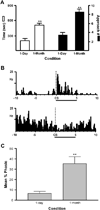Dissecting motivational circuitry to understand substance abuse
- PMID: 18625253
- PMCID: PMC2771685
- DOI: 10.1016/j.neuropharm.2008.06.028
Dissecting motivational circuitry to understand substance abuse
Abstract
An important goal of cocaine addiction research is to understand the neurobiological mechanisms underlying this disease state. Here, we review studies from our laboratory that examined nucleus accumbens (NAc) cell firing and rapid dopamine signaling using electrophysiological and electrochemical recordings in behaving rodents. A major advantage of these techniques is that they allow for the characterization of NAc activity and rapid dopamine release during specific phases of motivated behavior. Moreover, each approach enables an examination of the dynamic nature of NAc signaling as a function of factors such as hedonics and associative learning. We show that NAc neurons differentially respond to rewarding and aversive stimuli and their predictors in a bivalent manner. This differential responding is modifiable and can be altered by the presentation of other natural rewards or cocaine. Likewise, the dynamic nature of NAc cell firing is also reflected in the differential activation of distinct populations of NAc neurons during goal-directed behaviors for natural versus drug rewards, and the heightened activation of some NAc neurons following cocaine abstinence. Our electrochemical data also show that rapid dopamine signaling in the NAc reflects primary rewards and their predictors and appears to modulate specific NAc neuronal responses. In some cases, these influences are observed in a regionally specific manner that matches previous pharmacological manipulations. Collectively, these findings provide critical insight into the functional organization of the NAc that can be used to guide additional studies aimed at dissecting the neural code underlying compulsive drug-seeking behavior.
Figures








References
-
- Ahmed SH, Kenny PJ, Koob GF, Markou A. Neurobiological evidence for hedonic allostasis associated with escalating cocaine use. Nat Neurosci. 2002;5:625–626. - PubMed
-
- Ahmed SH, Koob GF. Transition from moderate to excessive drug intake: change in hedonic set point. Science. 1998;282:298–300. - PubMed
-
- Arbuthnott GW, Wickens J. Space, time and dopamine. Trends Neurosci. 2007;30:62–69. - PubMed
-
- Baldo BA, Kelley AE. Discrete neurochemical coding of distinguishable motivational processes: insights from nucleus accumbens control of feeding. Psychopharmacology (Berl) 2007;191:439–459. - PubMed
Publication types
MeSH terms
Grants and funding
LinkOut - more resources
Full Text Sources
Medical

